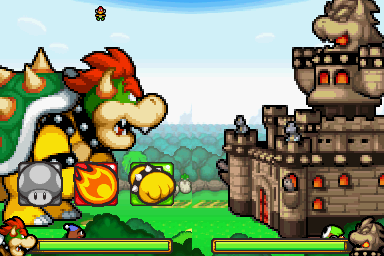
After battles, either the Bros, Bowser, or both may receive experience. These battles are entirely stylus based, and the DS is held like a book.įinally, Bowser's Inside Story is an RPG, and the statistic system reflects this. In addition, at specific points in the game, Bowser may find himself with a larger enemy to face and he grows accordingly. His special attacks are based upon using the stylus of the DS to use his minions to attack, such as a Goomba Storm. While his dodges/counter-attacks are based on punching and using his shell to protect himself. in battle can also dodge and counter-attack by either jumping at very specific points of the enemies attacks, making the battle system feel very rhythm based both in attacking and in defending.īowser handles similarly in battle, except that he is the only one in battle against the enemies, and his standard attacks are based on punching, fire breath, and vacuum breath, The Statistics Screen. In the standard attacks, pressing a specific button again for jumping, or releasing a button at the right time can give a damage boost. attacks requiring very specific timing depending on the attack, but with a very large damage if it lands perfectly. The Brothers can attack by jumping, hammering, or using special Bros. It is a turn based combat system, so the Mario Brothers each take a turn, and the enemies take a turn, with turn order based on the speed statistic. The Battle system for Bowser's Inside Story stays fairly similar to previous incarnations in the series. In the overworld, he can access areas that the Bros.

except that he cannot jump, but has other abilities like flame breath, ground pound and more. Using Bowser is similar to the Mario Bros. In addition to playing as the Mario Brothers, the player also actively controls Bowser for a significant portion of the game. Upon viewing an enemy in the overworld map, the player can actively attempt to avoid the battle, passively engage in battle by simply running into the enemy, or The Mario Brothers in Battle.Īctively engage in battle by either jumping on the enemy or hammering the enemy. At these towns, the player can purchase upgraded equipment such as new overalls, gloves, etc, as well as purchase items to use inside of battle. The overworld is also how the player visits towns, such as Toad Town, or the small market inside of Bowser's body. When reaching an impassible obstacle, usually an ability found later in the game will be required to proceed at that particular point such as the spin jump and hammer Mini Mario, among others. The overworld includes some puzzle solving at times, as well as the use of multiple learned abilities. During the times the player controls Bowser, as well as later in the game when the brothers escape Bowser's body, the gameplay is in the classic Mario & Luigi 3D overworld. (except more overworld-based, rather than level-based). While the brothers are inside of Bowser's body, the gameplay is in two dimensions, similar to the classic Super Mario Bros. Mario & Luigi: Bowser's Inside Story uses a mix of real-time overworld platforming and a turn-based battle system.įor the first time in the series, the platforming overworld sections are not entirely three-dimensional. Gameplay Bowser Battling an Overweight Goomba. While similar, Bowser uses a different arsenal, and his special attacks make use of the touch-screen and, unfortunately, the microphone, unlike the mustachioed brothers. Likewise, most enemy attacks can be partially blocked, avoided, or even countered, again, with appropriately timed actions. Every attack can be enhanced with well-timed button presses. Like the other games in the series, most battles rely on reflex/timing-based attacks. The game features multiple uses of every Nintendo DS capability, both in controls and graphics. The gameplay is split between playing as Mario and Luigi (as a team) and as Bowser. Bowser's Inside Story received critical acclaim, often regarded as being the best in the series.

The game includes several new features, such as the ability to play as Bowser. The game was first announced at Nintendo's conference in October 2008. It was released for the Nintendo DS on September 14, 2009, in the United States. Mario & Luigi: Bowser's Inside Story is the third title in the Mario & Luigi franchise.


 0 kommentar(er)
0 kommentar(er)
